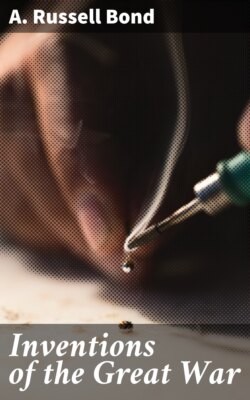Читать книгу Inventions of the Great War - A. Russell Bond - Страница 15
На сайте Литреса книга снята с продажи.
STRIKING A LIGHT
ОглавлениеTable of Contents
The lighting of the grenade fuses with a cigarette did very well for the early tin-can grenades, but the cigarettes were not always handy, particularly in the heat of battle, and something better had to be devised. One scheme was to use a safety-match composition on the end of a fuse. This was covered with waxed paper to protect it from the weather. The grenadier wore an armlet covered with a friction composition such as is used on a safety-match box. Before the grenade was thrown, the waxed paper was stripped off and the fuse was lighted by being scratched on the armlet. In another type the fuse was lighted by the twisting of a cap which scratched a match composition on a friction surface. A safety-pin kept the cap from turning until the grenadier was ready to throw the grenade.
The Mills hand-grenade, which proved to be the most popular type used by the British Army, was provided with a lever which was normally strapped down and held by means of a safety-pin. Fig 4 shows a sectional view of this grenade. Just before the missile was thrown, it was seized in the hand so that the lever was held down. Then the safety-pin was removed and when the grenade was thrown, the lever would spring up under pull of the spring A. This would cause the pin B to strike the percussion cap C, which would light the fuse D. The burning fuse would eventually carry the fire to the detonator E, which would touch off the main explosive, shattering the shell of the grenade and scattering its fragments in all directions. The shell of the grenade was indented so that it would break easily into a great many small pieces.
Fig. 4. Details of the Mills hand grenade
There were some advantages in using grenades lighted by fuse instead of percussion, and also there were many disadvantages. If too long a time-fuse were used, the enemy might catch the grenade, as you would a baseball and hurl it back before it exploded. This was a hazardous game, but it was often done.
Fig. 5. A German parachute grenade
Fig. 6. British rifle grenade with a safety-device which is unlocked by the rush of air against a set of inclined vanes, D, when the missile is in flight
Among the different types of grenades which the Germans used was one provided with a parachute as shown in Fig. 5. The object of the parachute was to keep the head of the grenade toward the enemy, so that when it exploded it would expend its energies forward and would not cast fragments back toward the man who had thrown it. This was a very sensitive grenade, arranged to be fired by percussion, but it was so easily exploded that the firing-mechanism was not released until after the grenade had been thrown. In the handle of this grenade there was a bit of cord about twenty feet long. One end of this was attached to a safety-needle, A, while the other end, formed into a loop, was held by the grenadier when he threw the grenade. Not until the missile had reached a height of twelve or thirteen feet would the pull of the string withdraw the needle A. This would permit a safety-hook, B, to drop out of a ring, C, on the end of a striker pellet, D. When the grenade struck, the pellet D would move forward and a pin, E, would strike a cap on the detonator F, exploding the missile. This form of safety-device was used on a number of German grenades.
The British had another scheme for locking the mechanism until after the grenade had traveled some distance through the air. Details of this grenade, which was of the type adopted to be fired from a rifle, are shown in Fig. 6. The striker A is retained by a couple of bolts, B, which in turn are held in place by a sleeve, C. On the sleeve is a set of wind-vanes, D. As the grenade travels through the air, the wind-vanes cause the sleeve C to revolve, screwing it down clear of the bolts B, which then drop out, permitting the pin A to strike the detonator E upon impact of the grenade with its target.
Fig. 7. Front, side, and sectional views of a disk-shaped German grenade
Fig. 8. A curious German hand grenade shaped like a hair brush
The Germans had one peculiar type which was in the shape of a disk. In the disk were six tubes, four of which carried percussion caps so that the grenade was sure to explode no matter on which tube it fell. The disk was thrown with the edge up, and it would roll through the air. Another type of grenade was known as the hair-brush grenade because it had a rectangular body of tin about six inches long and two and three quarter inches wide and deep, which was nailed to a wooden handle.
